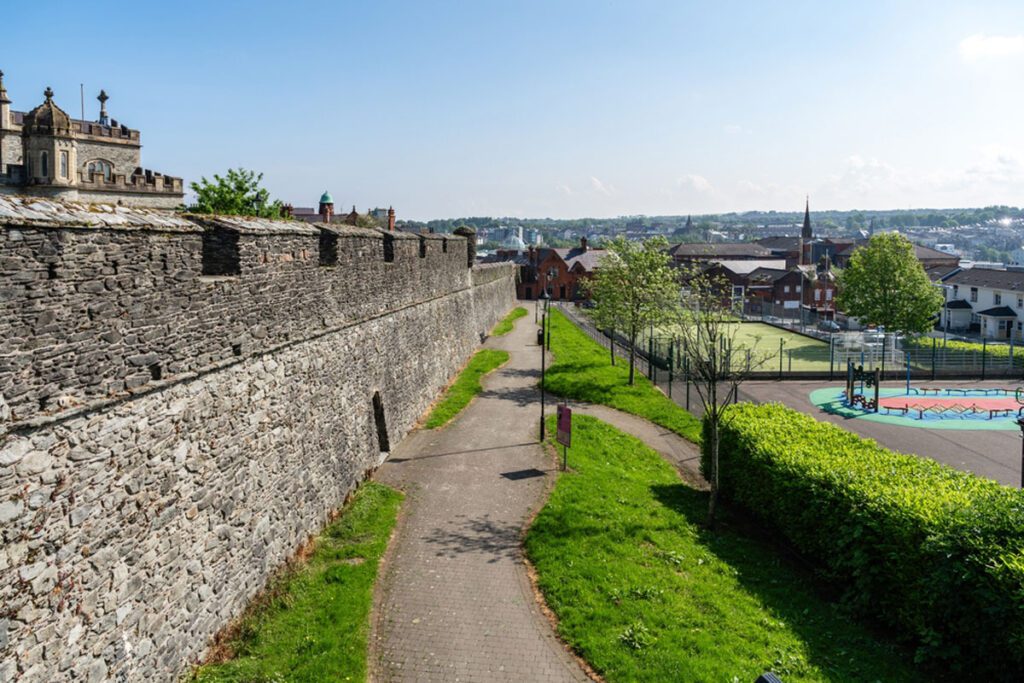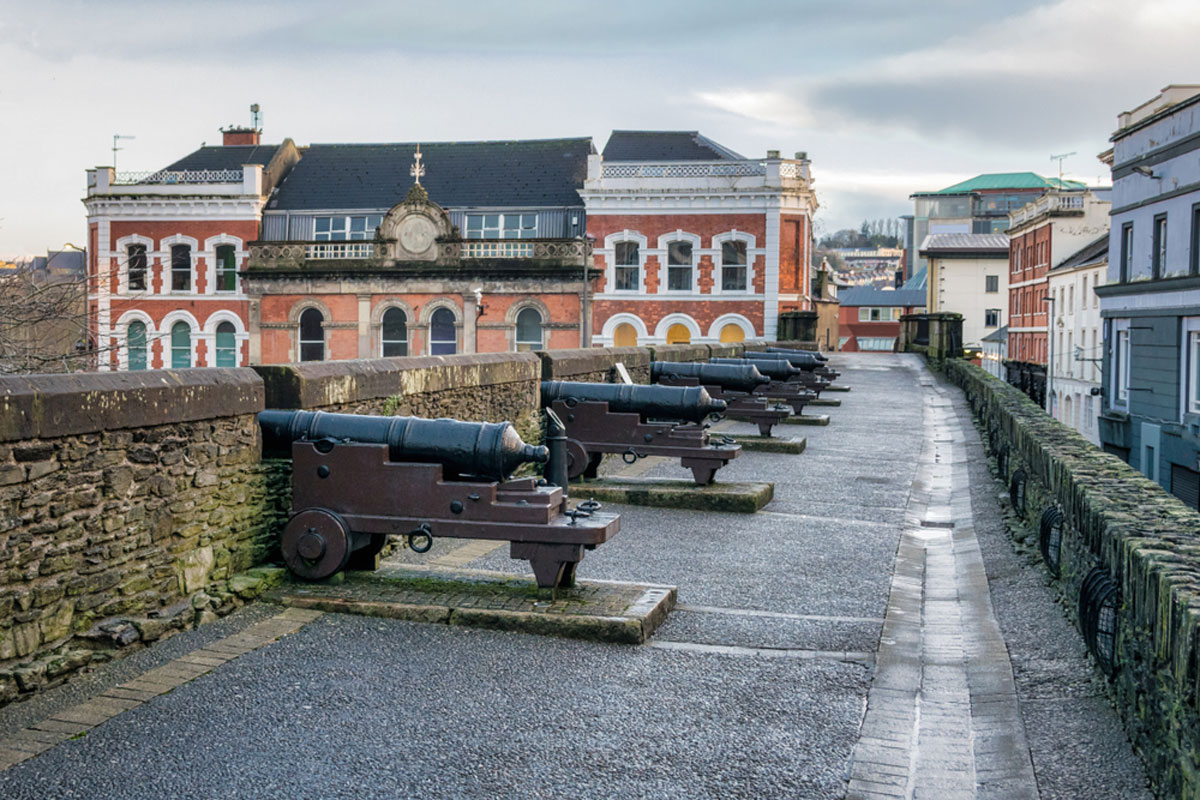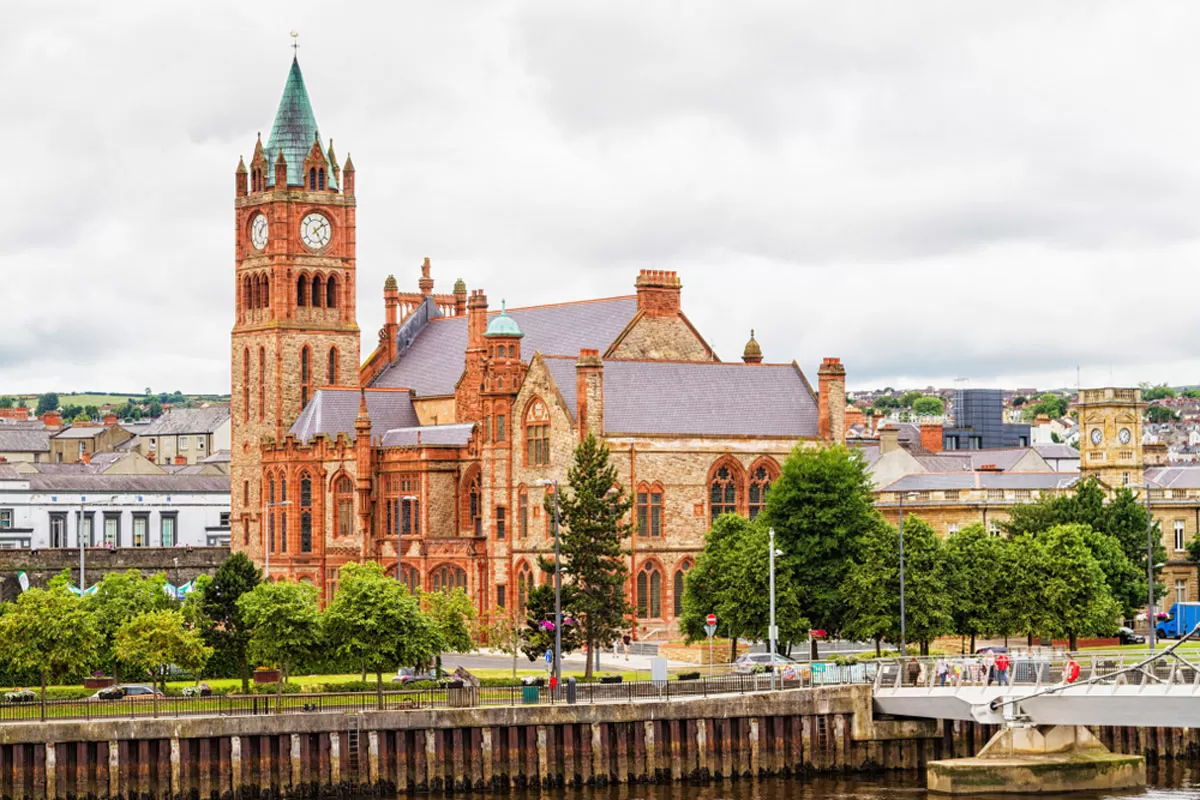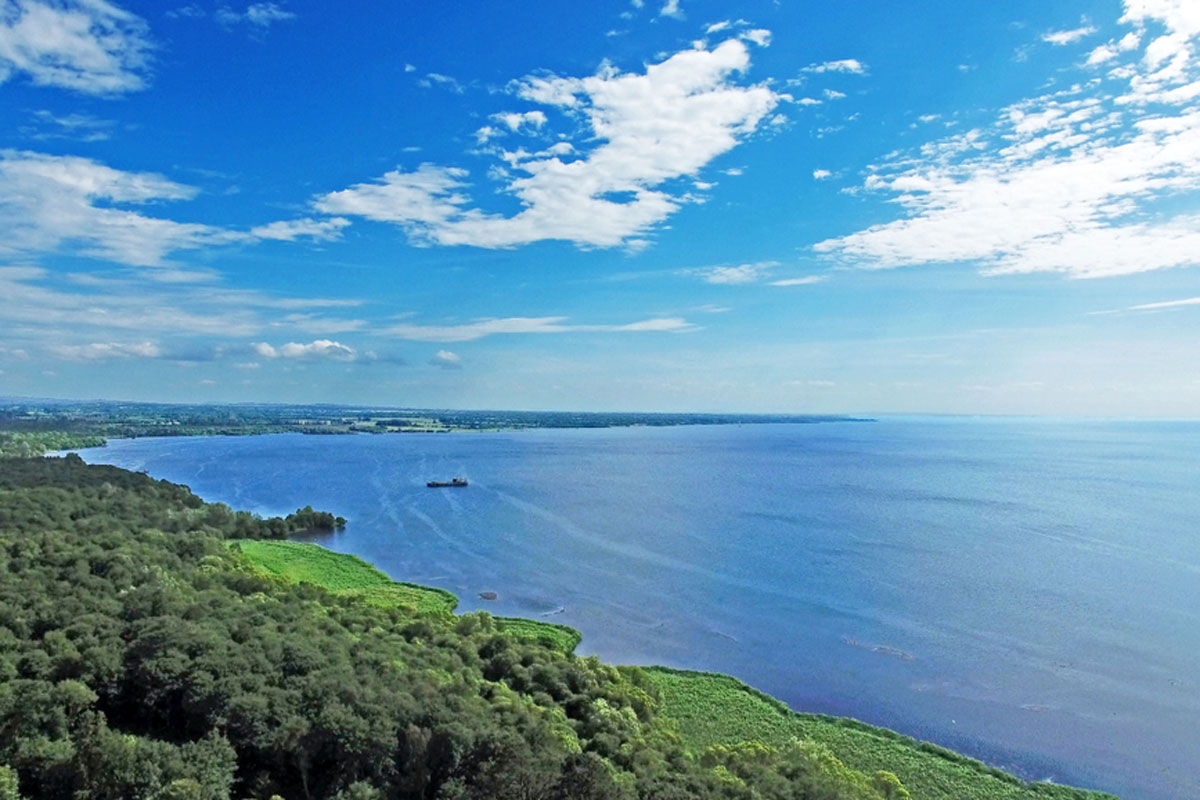The Origins and Construction of the Walls
Standing tall for over 400 years, the Derry City Walls are among the finest examples of 17th-century fortifications in Europe. Encircling the heart of Derry, these historic walls serve as a remarkable reminder of the city’s turbulent past, as well as its resilience and cultural significance. Built between 1613 and 1619, the walls were constructed to defend the newly established English and Scottish settlers during the period known as the Plantation of Ulster. Today, they remain one of Ireland’s most important heritage sites, offering visitors an opportunity to walk in the footsteps of history.
Why Were the Walls Built?
The early 17th century was a time of significant conflict and change in Ireland. Following the defeat of Gaelic Irish lords in the Nine Years’ War (1594–1603) and their subsequent exile in the Flight of the Earls (1607), the English Crown sought to secure its rule over Ulster, the most Gaelic and traditionally independent part of Ireland. To achieve this, King James I initiated the Plantation of Ulster, bringing English and Scottish Protestant settlers into the region to establish control over the native Irish population.
Derry, strategically located along the River Foyle, was chosen as a key stronghold. To protect the new settlers from potential uprisings by the displaced Gaelic Irish, The Honourable The Irish Society, a London-based guild, financed the construction of a fortified city. The walls were designed to withstand attack and provide a safe haven for the settlers.
The Design and Construction
The Derry City Walls were built in a distinctive Renaissance-style star fort pattern, influenced by European military architecture of the time. The walls form an almost completely intact oval enclosure, stretching approximately 1.5 kilometers (1 mile) around the old city. Constructed primarily of stone and earth, they rise to an average height of 8 meters (26 feet) and are up to 9 meters (30 feet) thick in places.
The design included four original gates:
- Bishop’s Gate
- Ferryquay Gate
- Butcher’s Gate
- Shipquay Gate
These gates provided controlled access to the city, allowing for trade and movement while ensuring security. Over time, three additional gates—Magazine Gate, Castle Gate, and New Gate—were added to accommodate the city’s expansion.
A City That Never Fell
One of the most remarkable facts about the Derry City Walls is that they have never been breached by an enemy force. Throughout the centuries, they withstood multiple sieges, the most famous being the Siege of Derry in 1689, when the city’s Protestant defenders held out against the forces of James II for 105 days. This resilience earned Derry the nickname “The Maiden City”, a testament to its unbroken defenses.
Legacy and Preservation
Today, the Derry City Walls remain one of Ireland’s most significant heritage landmarks, attracting thousands of visitors each year. Walking along the ramparts, visitors can enjoy stunning views of the River Foyle, the modern city, and historic sites within the walls. The walls are also home to 24 original cannons, including the famous “Roaring Meg”, a powerful artillery piece used during the Siege of Derry.
The preservation of the walls allows visitors to step back in time and appreciate the rich history that shaped Derry. More than just a defensive structure, the walls symbolize the city’s endurance, cultural heritage, and evolving identity over the centuries.
The Role of the Walls in the Siege of Derry
The Siege of Derry (1689) remains one of the most defining moments in the history of Derry City Walls. This dramatic event, lasting 105 days, tested the resilience of the city’s defenders and cemented Derry’s reputation as “The Maiden City”, a name reflecting the fact that its walls were never breached.
The Conflict Leading to the Siege
The siege took place during the wider struggle between King James II, a Catholic monarch, and William of Orange, a Protestant prince who had taken the English throne during the Glorious Revolution. James, determined to reclaim his throne, sought to use Ireland as a base for his comeback, rallying Irish Catholic forces against Protestant strongholds.
Derry, a predominantly Protestant city, became a key strategic point in this conflict. As James’s forces, known as the Jacobites, advanced toward the city in April 1689, the people of Derry faced a critical decision—surrender or resist.
The Famous Cry: “No Surrender!”
On December 7, 1688, months before the siege officially began, a group of 13 apprentice boys famously shut the gates of Derry against the advancing Jacobite forces. Their defiant act marked the first open resistance to James II in Ireland. This moment is still commemorated today by the Apprentice Boys of Derry, who hold an annual parade in honor of their bravery.
When James himself arrived at the walls in April 1689 and demanded surrender, the response from within was clear and resolute: “No Surrender!”
The Siege Begins
James’s army, numbering around 12,000 men, surrounded the city, cutting off all food and supplies in an attempt to starve the defenders into submission. Inside the walls, around 30,000 people, including soldiers and civilians, endured extreme hardship. Food became so scarce that people were forced to eat dogs, horses, and even leather to survive.
The city’s defenders, under the leadership of Major Henry Baker and Colonel Adam Murray, held their ground despite relentless bombardment from Jacobite cannons. The most famous of these cannons, “Roaring Meg”, still stands on the walls today, a symbol of the city’s resistance.
Breaking the Siege
As the weeks dragged on, disease and starvation took a heavy toll, but the defenders refused to surrender. The breakthrough finally came on July 28, 1689, when Royal Navy ships, led by Major-General Percy Kirke, broke through a blockade at Boom Hall on the River Foyle and delivered much-needed supplies to the starving city. This moment, known as the Relief of Derry, forced the Jacobite forces to retreat, ending the 105-day siege.
Legacy of the Siege
The Siege of Derry remains a deeply significant event in Irish and British history. It was a defining moment in the struggle between Protestant and Catholic forces in Ireland, and its legacy still influences the cultural and political landscape of Northern Ireland today.
For many, the Derry City Walls are not just a historical monument but a living symbol of determination, resilience, and identity. Walking along the walls, visitors can still see the spots where cannon fire hit, and they can stand at the same gates where the apprentice boys made their famous stand.
The siege is commemorated each year with parades and events that keep the memory of these events alive, ensuring that the story of “No Surrender” is never forgotten.
The Cannons of Derry – Guardians of the Walls
One of the most striking features of the Derry City Walls is the presence of 24 original cannons, each a silent guardian of the city’s rich and turbulent past. These heavy artillery pieces, some dating back to the 17th century, played a vital role in defending Derry, particularly during the Siege of 1689. Today, they stand as powerful symbols of the city’s resilience and history, offering visitors a tangible link to the battles and sieges that shaped its destiny.
The Cannons and Their Purpose
The primary function of the Derry City Walls was defense, and the cannons placed along the ramparts were a crucial part of the city’s fortifications. Positioned at key strategic points, these cannons were used to deter attackers, fire upon advancing armies, and protect the city from potential breaches. During the Siege of Derry, they were fired relentlessly at the Jacobite forces, who had surrounded the city in an attempt to force a surrender.
The walls, designed in a bastioned star-fort style, provided ideal placements for the cannons, allowing defenders to fire in multiple directions and cover all approaches to the city. This strategic positioning contributed to Derry’s ability to withstand sieges and cemented its reputation as “The Maiden City.”
Roaring Meg: The Most Famous Cannon
Among the many cannons on display, the most famous is undoubtedly “Roaring Meg.” This large and powerful mortar played a key role in the city’s defense during the Siege of 1689.
Why is Roaring Meg so legendary?
- It was one of the loudest and most destructive cannons used by the defenders.
- Positioned on Double Bastion, it fired devastating shots at Jacobite troops stationed outside the walls.
- It became a symbol of the city’s defiance and strength, a reputation it holds to this day.
Visitors to the Double Bastion can still see Roaring Meg in its original position, where it remains one of the most photographed artifacts on the walls.
Other Notable Cannons
While Roaring Meg is the most famous, several other cannons remain in excellent condition, each with its own story to tell. Some of these include:
- Long Tom – A cannon with a particularly long barrel, designed for greater range.
- Queen Anne Cannon – Named after the monarch, this piece reflects the city’s continued military importance after the 17th century.
- The Three Brothers – A set of cannons positioned together, providing concentrated firepower in a key section of the walls.
Each of these cannons played a role in securing the city against attackers and remains a testament to Derry’s strategic military planning.
Preservation and Legacy
The Honourable The Irish Society, responsible for the original construction of the walls, has worked alongside various heritage groups to ensure the preservation of the cannons. Over the years, they have been carefully restored and maintained so that visitors can experience them as they were centuries ago.
The cannons also serve as a reminder of Derry’s historical significance, bridging the gap between past and present. While they once roared in defense of the city, today they stand in silent tribute to the events that shaped Derry/Londonderry.
For visitors walking the Derry City Walls, the cannons are more than relics—they are symbols of the city’s endurance, heritage, and historical legacy.

The Walls and Their Influence on Modern Derry
The Derry City Walls are not just relics of the past—they continue to shape the identity, culture, and landscape of modern Derry. As a living monument, the walls have evolved from military fortifications into a symbol of the city’s complex history and a key attraction for visitors. They stand as a reminder of past conflicts but also serve as a bridge toward reconciliation and cultural appreciation in Northern Ireland today.
A Divided Past, A Shared Future
For centuries, the walls have been at the heart of Derry’s political and religious divisions. Built in the early 17th century to protect Protestant settlers during the Plantation of Ulster, the walls later became a focal point of sectarian tensions, particularly during the conflicts of the 20th century.
During the period known as The Troubles (1968–1998), the walls stood between the mainly Catholic Bogside area and the predominantly Protestant Fountain Estate. These divisions were deeply felt, and for many, the walls symbolized separation and exclusion rather than unity. However, in the years since the Good Friday Agreement (1998), Derry has worked hard to redefine the walls as a shared heritage site, promoting them as a place for all communities to engage with their city’s past and future.
The Walls as a Tourist Attraction
Today, the Derry City Walls are among the most visited heritage sites in Northern Ireland, attracting thousands of visitors every year. They provide a unique, walkable history tour, offering panoramic views of the city and access to key landmarks, including:
- St. Columb’s Cathedral – The oldest building within the walls, dating back to 1633.
- The Guildhall – A stunning neo-Gothic building with impressive stained glass windows.
- The Tower Museum – A museum offering a deep dive into Derry’s rich and often turbulent history.
Walking along the 1.5-kilometer circuit of the walls allows visitors to see Derry’s past and present intertwine, from historic cannons to vibrant murals that tell the city’s story.
Cultural Celebrations and Events
In recent years, the Derry City Walls have become the backdrop for some of the city’s biggest cultural events. These include:
- The Apprentice Boys’ Parade – A yearly commemoration of the closing of the gates in 1688, drawing thousands of participants.
- Derry Halloween Festival – One of the largest Halloween celebrations in Europe, where the walls are illuminated and host a variety of performances.
- Foyle Maritime Festival – A celebration of Derry’s connection to the River Foyle, featuring live music, food markets, and cultural events.
Through these events, the walls have transformed from a site of division into a platform for cultural expression and celebration, fostering a sense of shared history and community.
Preserving the Walls for Future Generations
The ongoing preservation of the Derry City Walls is crucial to maintaining their historical and cultural significance. Efforts by heritage organizations and local authorities ensure that the walls remain accessible and well-maintained. Conservation projects focus on:
- Restoring damaged stonework
- Preserving historic cannons and landmarks
- Enhancing accessibility for all visitors
The walls are now recognized as a symbol of both resilience and reconciliation, showing how history can be preserved while also paving the way for a more inclusive future.
While originally built for protection and division, the Derry City Walls have evolved into a powerful symbol of shared heritage, culture, and tourism. Their influence on modern Derry is undeniable, as they continue to serve as a reminder of the city’s past while inspiring a future of unity and understanding.
Walking the Walls – A Visitor’s Guide
Exploring the Derry City Walls is one of the best ways to experience the city’s rich history, culture, and stunning views. Whether you’re a history enthusiast, a casual traveler, or a local rediscovering your city, walking the walls offers a unique perspective on Derry. This guide will help you make the most of your visit.
Starting Your Walk
The Derry City Walls form a 1.5-kilometer (1 mile) circuit, completely encircling the old city. The walk is relatively easy, with well-maintained paths and a few gentle inclines. You can start your walk at any of the seven gates, but a popular starting point is Bishop’s Gate, where you’ll get a great first view of the walls’ imposing structure.
Must-See Stops Along the Walls
As you make your way around, be sure to take in these key sites:
1. Bishop’s Gate
One of the original four gates, Bishop’s Gate is an excellent starting point, leading you to Double Bastion, where you’ll find the famous Roaring Meg cannon.
2. The Guildhall
Located just outside the walls, this stunning neo-Gothic building features beautiful stained-glass windows and tells the story of Derry’s history, including the Plantation of Ulster.
3. St. Columb’s Cathedral
Built in 1633, this is the oldest surviving building in the city. It houses fascinating relics from the Siege of Derry and offers a peaceful break from the bustling city streets.
4. The Tower Museum
If you want to take a deeper dive into Derry’s history, step inside the Tower Museum, which has exhibits covering everything from the Spanish Armada to The Troubles.
5. Shipquay Gate
A bustling area with a steep descent leading into the modern city center. This is a great spot for shopping, dining, and taking in the energy of the city.
6. The Bogside Murals (View from the Walls)
As you walk along the western side of the walls, you’ll get a clear view of the famous Bogside Murals, which depict key events from The Troubles, including the Bloody Sunday massacre.
7. Butcher’s Gate and The Fountain Estate
As you pass Butcher’s Gate, you’ll see The Fountain, a small Protestant enclave. This area is a reminder of the city’s religious and cultural diversity.
Tips for Walking the Walls
- Wear comfortable shoes – The walls are paved but uneven in places.
- Take your time – While the full circuit takes about 30–45 minutes, allow extra time to stop at landmarks.
- Visit early or late in the day – To avoid crowds and enjoy the best lighting for photos.
- Check the weather – The walls are exposed, so bring an umbrella or sun protection, depending on the season.
- Join a guided tour – Local guides provide incredible insight into the city’s history and its significance.
A Journey Through Time
Walking the Derry City Walls is more than just a sightseeing experience—it’s a journey through centuries of history, resilience, and cultural evolution. From their origins in the 17th century to their modern role as a symbol of shared heritage, the walls continue to stand as one of Ireland’s most important landmarks.
Whether you’re admiring the historic cannons, learning about the Siege of Derry, or taking in the views of the River Foyle, a walk along the walls is an unforgettable experience that connects the past with the present.
Conclusion
The Derry City Walls are a testament to the city’s rich history, resilience, and transformation. What was once a military stronghold is now a place of exploration, education, and cultural significance. By walking the walls, you step into the story of Derry, a city shaped by its past but always looking toward the future.
No visit to Derry is complete without a walk on its historic walls—where history lives and breathes with every step.
Natural Attractions
- Mussenden Temple and Downhill Demesne – A cliffside temple with breathtaking views of the Atlantic Ocean and surrounding countryside.
- Benone Strand – One of Ireland’s longest beaches, perfect for walking, swimming, and surfing.
- Roe Valley Country Park – A peaceful park offering woodland trails, waterfalls, and historical sites.
- Binevenagh Mountain – Known for its dramatic cliffs and panoramic views over Lough Foyle and beyond.
- Lough Foyle – A scenic estuary ideal for birdwatching, boating, and enjoying coastal views.
Historical and Cultural Sites
- Derry City Walls – The well-preserved 17th-century walls encircling the city, offering a glimpse into its history.
- Guildhall – A stunning neo-Gothic building with beautiful stained glass windows and historical exhibitions.
- Museum of Free Derry – A museum dedicated to the civil rights movement and the city’s political history.
- St. Columb’s Cathedral – A 17th-century Anglican cathedral and one of the city’s iconic landmarks.
- Tower Museum – Explore the story of Derry through engaging exhibits, including the Spanish Armada shipwreck.
Lakes and Water Activities
- Lough Neagh – The largest freshwater lake in the British Isles, offering fishing, boating, and birdwatching opportunities.
- River Foyle – A picturesque river flowing through Derry City, popular for walking and riverfront activities.
- Ballyronan Marina – A tranquil spot for water sports, picnics, and scenic views.
Scenic Drives and Villages
- Causeway Coastal Route – A stunning drive featuring dramatic coastline, charming villages, and nearby attractions like Giant’s Causeway.
- Castlerock – A quaint seaside village with a beautiful beach and easy access to Mussenden Temple.
- Magherafelt – A vibrant market town known for its cultural events and historical landmarks.
Unique Experiences
- Peace Bridge – A striking modern bridge symbolizing unity, connecting both sides of Derry City.
- Seamus Heaney HomePlace – A literary and arts center celebrating the life and work of Nobel Laureate Seamus Heaney.
- Derry Halloween Festival – Renowned as one of the best Halloween celebrations in the world.
- Broighter Gold – Visit the area where this famous hoard of ancient gold artifacts was discovered.
- Waterside Theatre – Hosting a variety of performances, from drama to live music.
County Derry (Londonderry) blends natural beauty, rich history, and vibrant culture, making it an unforgettable destination for visitors.
Helpful Resources






